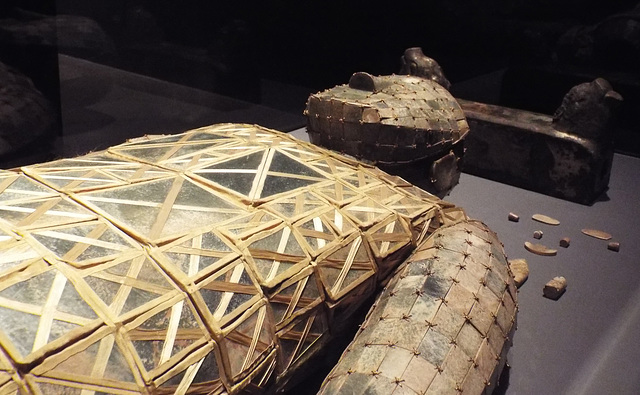Group of Chariot Drivers, Chariot Riders, and Infa…
Group of Chariot Drivers, Chariot Riders, and Infa…
Chariot Driver in the Metropolitan Museum of Art,…
Chariot Driver in the Metropolitan Museum of Art,…
Dog Terracotta Sculpture in the Metropolitan Museu…
Dog Terracotta Sculpture in the Metropolitan Museu…
Han Incense Burner in the Metropolitan Museum of A…
Han Incense Burner in the Metropolitan Museum of A…
Han Incense Burner in the Metropolitan Museum of A…
Han Incense Burner in the Metropolitan Museum of A…
Ornamental Plaque with a Bullfight in the Metropol…
Ornamental Plaque with a Bullfight in the Metropol…
Strongman in the Metropolitan Museum of Art, July…
Strongman in the Metropolitan Museum of Art, July…
Han Tomb Gate in the Metropoiltan Museum of Art, J…
Han Tomb Gate in the Metropoiltan Museum of Art, J…
Han Model of a Dyeing Workshop in the Metropolitan…
Han Model of a Dyeing Workshop in the Metropolitan…
Han Model of a Dyeing Workshop in the Metropolitan…
Carnelian Animal-Shaped Ornaments in the Metropoli…
Carnelian Animal-Shaped Ornaments in the Metropoli…
Brick with a Scene of Salt Production in the Metro…
Brick with a Scene of Salt Production in the Metro…
Detail of the Burial Ensemble of Dou Wan in the Me…
The Burial Ensemble of Dou Wan in the Metropolitan…
The Burial Ensemble of Dou Wan in the Metropolitan…
The Burial Ensemble of Dou Wan in the Metropolitan…
The Burial Ensemble of Dou Wan in the Metropolitan…
6 Beads with Granulated Decoration in the Metropol…
6 Beads with Granulated Decoration in the Metropol…
Beaded Necklaces from India in the Metropolitan Mu…
Beaded Necklaces from India in the Metropolitan Mu…
Han Dynasty Pillow in the Metropolitan Museum of A…
Han Dynasty Pillow in the Metropolitan Museum of A…
Bronze Water Clock in the Metropolitan Museum of A…
Bronze Water Clock in the Metropolitan Museum of A…
Detail of the Codex Mendoza in the Metropolitan Mu…
Detail of the Codex Mendoza in the Metropolitan Mu…
Codex Mendoza in the Metropolitan Museum of Art, M…
Codex Mendoza in the Metropolitan Museum of Art, M…
Detail of a Mayan Vessel with a Palace Scene in th…
Detail of a Mayan Vessel with a Palace Scene in th…
Mayan Vessel with a Palace Scene in the Metropolit…
Mayan Vessel with a Palace Scene in the Metropolit…
Mayan Cylinder Vessel with a Palace Scene in the M…
Keywords
Authorizations, license
-
Visible by: Everyone -
All rights reserved
-
176 visits
Detail of the Burial Ensemble of Dou Wan in the Metropolitan Museum of Art, July 2017


Burial Ensemble of Dou Wan
Object Details
Period: Western Han dynasty (206 B.C.–A.D. 9)
Culture: China
Medium: Suit: jade (nephrite) with gold wire; pillow: gilt bronze and jade (nephrite); orifice plugs: jade (nephrite)
Dimensions: H. 67 11/16 in. (171.9 cm); W. 30 7/8 in. (78.4 cm); D. 11 1/2 in. (29.2 cm); Wt. 77.2 lb. (35 kg)
Classification: Jade
Credit Line: Lent by Hebei Provincial Museum and Hebei Provincial Institute of Cultural Relics
This burial ensemble was excavated from the tomb of Dou Wan, wife of Prince Liu Sheng of Zhongshan. The suit consists of small jade plaques, each meticulously shaped and fitted together with gold wire to delineate the curves of the body. It represents the completion of a magical transformation of a deceased individual’s body, accomplished through a layering of jades. The first layer would have been the set of jade plugs seen here, which were inserted into the nine bodily orifices to seal the corpse. Next came a layer of small and large bi disks. The corpse was then encased in this suit, its head resting on the accompanying pillow. The ensemble of jades protected the body and the soul in their entirety, enabling the deceased to attain immortality.
Text from: www.metmuseum.org/art/collection/search/696308
Object Details
Period: Western Han dynasty (206 B.C.–A.D. 9)
Culture: China
Medium: Suit: jade (nephrite) with gold wire; pillow: gilt bronze and jade (nephrite); orifice plugs: jade (nephrite)
Dimensions: H. 67 11/16 in. (171.9 cm); W. 30 7/8 in. (78.4 cm); D. 11 1/2 in. (29.2 cm); Wt. 77.2 lb. (35 kg)
Classification: Jade
Credit Line: Lent by Hebei Provincial Museum and Hebei Provincial Institute of Cultural Relics
This burial ensemble was excavated from the tomb of Dou Wan, wife of Prince Liu Sheng of Zhongshan. The suit consists of small jade plaques, each meticulously shaped and fitted together with gold wire to delineate the curves of the body. It represents the completion of a magical transformation of a deceased individual’s body, accomplished through a layering of jades. The first layer would have been the set of jade plugs seen here, which were inserted into the nine bodily orifices to seal the corpse. Next came a layer of small and large bi disks. The corpse was then encased in this suit, its head resting on the accompanying pillow. The ensemble of jades protected the body and the soul in their entirety, enabling the deceased to attain immortality.
Text from: www.metmuseum.org/art/collection/search/696308
- Keyboard shortcuts:
Jump to top
RSS feed- Latest comments - Subscribe to the comment feeds of this photo
- ipernity © 2007-2024
- Help & Contact
|
Club news
|
About ipernity
|
History |
ipernity Club & Prices |
Guide of good conduct
Donate | Group guidelines | Privacy policy | Terms of use | Statutes | In memoria -
Facebook
Twitter

Sign-in to write a comment.